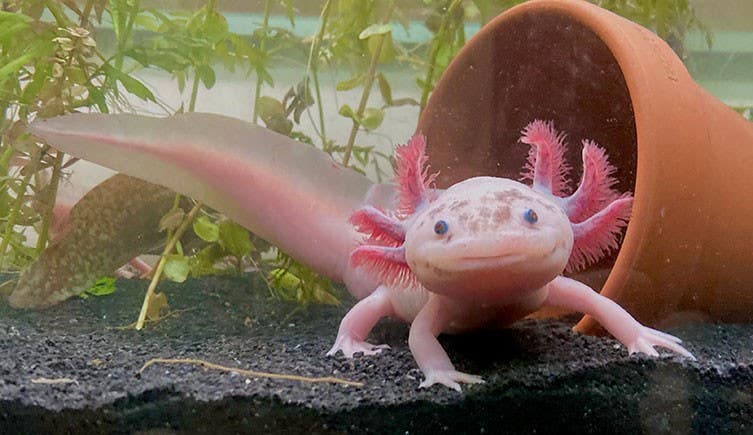These endangered sea creatures are over 1,000x more resistant to cancer than humans
Ecologists are waging a determined battle to rescue a creature near extinction, one they believe holds the key to major medical discoveries

[Dec. 15, 2023: JD Shavit, The Brighter Side of News]
Axolotls are brown-grey in the wild, but are sometimes bred to be pink. (CREDIT: Robert Röhl)
In the heart of Mexico, ecologists are waging a determined battle to rescue a creature on the brink of extinction, one they believe holds the key to groundbreaking medical discoveries. This remarkable species, the axolotl, often referred to as a "water monster," has not only captured the hearts of Mexicans, becoming a cultural icon, but it also possesses astonishing regenerative abilities that could revolutionize fields like tissue repair and cancer recovery.
The axolotl, a fish-like salamander with a perpetual smile, is a charismatic and endearing creature that has thrived in Mexico's waters for centuries. However, the once-abundant population of axolotls has been decimated, with their numbers plummeting by a staggering 99.5%, according to scientists leading the conservation efforts. A stark reality has emerged, underscoring the urgent need for intervention.
In response to this dire situation, a group of dedicated ecologists has launched a fundraising campaign aimed at saving the axolotl from the precipice of extinction. They are appealing to the public to contribute 600 pesos (equivalent to approximately $35) to virtually "adopt" one of these enchanting creatures.
So far, the fundraiser has managed to generate just over 450,000 pesos, equivalent to $26,300, which has been channeled into a captive breeding program. While this is a commendable start, the scientists emphasize that they are still far from possessing the necessary resources to effectively combat the crisis.
Related Stories
"We lack big monitoring of all the streams in Mexico City," explains Alejandro Calzada, one of the ecologists actively involved in the axolotl conservation efforts. "For this large area, it is not enough."
The urgency of the situation cannot be overstated. Recent research has revealed that there are now fewer than 1,000 Mexican axolotls remaining in the wild. Time is of the essence, as Calzada underscores, "We have to work urgently."
The Enigmatic Axolotl
Beyond its undeniable charm, the axolotl possesses an array of astonishing characteristics that make it a subject of fascination for both scientists and the public alike. Described as "friendly-faced salamanders that stay in their 'tadpole' form forever" by the Natural History Museum, these creatures have intrigued generations.
Yet, it is their regenerative prowess that truly sets the axolotl apart. They can regrow not only their limbs but also vital organs, including their lungs, heart, jaw, spine, and even portions of their brain. The exact mechanisms governing this remarkable ability continue to elude scientists, but they hold great promise for applications in human medicine.
"Axolotls are over 1,000 times more resistant to cancer than mammals — another superpower worth investigating," notes the San Diego Zoo. This exceptional resistance to cancer opens up a tantalizing avenue of research that could potentially lead to new breakthroughs in the fight against this devastating disease.
Conservation Beyond Utility
While the axolotl's endearing appearance and potential medical benefits may garner public attention, it is crucial to emphasize that a species does not need to be cute or directly beneficial to humans to warrant preservation. The loss of any species is a profound tragedy with far-reaching consequences for the delicate balance of its ecosystem.
In the case of the axolotl, its role extends beyond its own survival. As a keystone species in its habitat, it plays a pivotal role in maintaining the ecological equilibrium of its environment. Any disruption to its population has cascading effects, ultimately impacting the entire ecosystem.
As ecologists rally to save the axolotl, they are not merely protecting a single species; they are safeguarding the intricate web of life that relies on the continued existence of this enigmatic creature. The potential medical advancements that may arise from studying the axolotl's regenerative abilities are a testament to the interconnectedness of the natural world.
The plight of the axolotl serves as a poignant reminder of the fragility of our planet's biodiversity. Conservation efforts like the campaign to save the axolotl are emblematic of the dedication and passion of scientists and activists determined to make a difference.
As the fundraising initiative continues, the importance of public support cannot be overstated. The symbolic act of "adopting" an axolotl virtually not only provides vital financial resources but also sends a powerful message of solidarity in the fight to preserve our planet's unique and irreplaceable life forms.
In the words of Alejandro Calzada, the urgency of this endeavor cannot be overstated. The fate of the axolotl and the ecological balance it upholds hang in the balance. "We have to work urgently," he implores, echoing the sentiments of ecologists and conservationists worldwide.
The future of the axolotl and the countless species like it depends on our collective efforts to preserve the natural wonders that make our world a truly remarkable place.
Note: Materials provided above by The Brighter Side of News. Content may be edited for style and length.
Like these kind of feel good stories? Get the Brighter Side of News' newsletter.
Joshua Shavit
Science & Technology Writer | AI and Robotics Reporter
Joshua Shavit is a Los Angeles-based science and technology writer with a passion for exploring the breakthroughs shaping the future. As a contributor to The Brighter Side of News, he focuses on positive and transformative advancements in AI, technology, physics, engineering, robotics and space science. Joshua is currently working towards a Bachelor of Science in Business Administration at the University of California, Berkeley. He combines his academic background with a talent for storytelling, making complex scientific discoveries engaging and accessible. His work highlights the innovators behind the ideas, bringing readers closer to the people driving progress.



